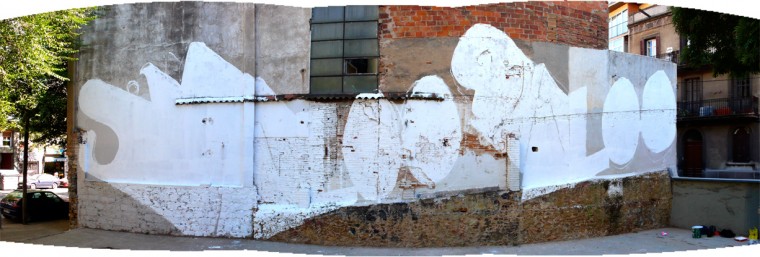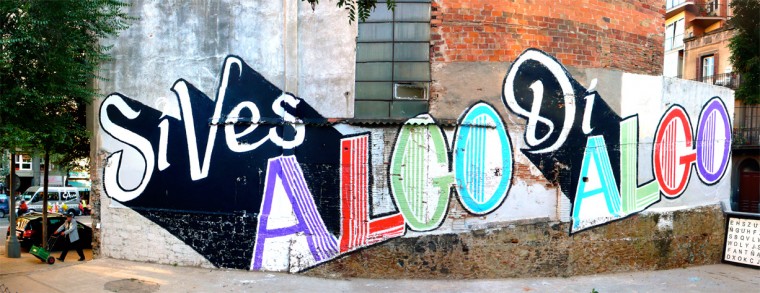The work of multimedia street and studio artist Ripo thrives on contexts. With legal and illegal pieces popping up in 36 countries, Ripo’s boldly crafted images and carefully hand-lettered slogans may appear anywhere from a European gallery to the side of an abandoned building in Central America. Wherever they appear, they comment on place: the place of the artist in a community as well as the place of the viewer in a public space. Even his assumed name, Ripo, is anonymous, malleable, and open to interpretation.
“Ripo (pronounced re-po) comes from ‘repossess’ and the idea of taking something back by doing it yourself,” he says. “Also, taking back public space, which should be ours anyway.”
A native New Yorker, Ripo moved to Barcelona four years ago, hoping to find a public space more conducive to experimentation and communication.
“That was right after I was able to escape from my university with a BFA degree in hand that I haven’t seen or thought about since graduation,” he says. “Barcelona has a lot of life and art in the streets, although its laws and attitudes towards graffiti and street culture in general have changed a lot since then. I had visited [Barcelona] a few years earlier, and it felt like a really free city, unlike most places in the US.”
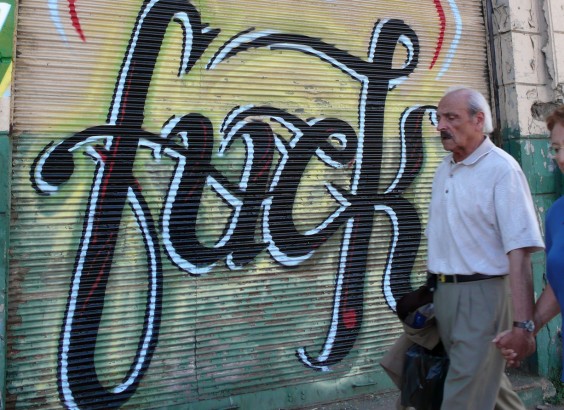
Graffiti culture in Europe has a long and politically engaged history, associated as much with strikes, protests, and revolutions as with music or fashion. Graffiti has a different meaning in these older cities than on the squeaky-clean newness of most American structures. In photographs of his street art in places like Sofia and Milan, Ripo’s newly painted signs affixed to public walls appear as only the latest in a series of historical accretions of signs, slogans, posters, and strips of paint that build like layers of fossils and sediment across piazzas and storefronts. What appears raw, shocking, and egregious in New York or Los Angeles feels somehow more organic, timeless, and at home in the Old World.
Part of this organic feeling may be a reflection of Spain’s relatively laid-back attitude towards graffiti. “Pre-2005,” Ripo says, “the city was pretty much a graffiti and street-art Mecca. Artists were traveling from all over the world to paint in the streets here since it was basically legal. Cops would drive by artists painting in the center of the city and applaud them on the work they were doing. In 2005, the civismo ordinances (similar to the Quality of Life laws passed in many cities in the US) were passed and cops immediately began giving out large fines (up to 3,000 euros), and the city began buffing years of artwork from the city’s walls. Millions of euros and four years later, the scene is still very strong — although it had a large down period — but it will never be as free as it was.”
“I can’t decide what’s an appropriate use of public space any more than any other one person — it should be public after all — but as an individual, I am actively going to do something about it.”
“I haven’t painted in many cities in the US, so I can’t really say,” Ripo continues. “But I’m pretty sure that there aren’t any cities anywhere in the country where it is as allowed as it was in Barcelona. [New York] is real tough, but it depends on the neighborhood. Downtown Manhattan is about as infested with undercover cops as it is with rats. They’re really angry, pathetic, abusive of power, have little regards for anyone’s rights, and profit from criminalizing people. American police absolutely work with a ‘guilty until proven innocent’ mentality, whereas in Barcelona, in the few encounters that I’ve had with the police, it’s the opposite, and I’ve managed to talk my way out of any fines or arrests.”
Ripo’s eclectic visual style is heavily indebted to calligraphy, sign painting, and typography. These textual elements capture the eye most strongly in works like “Si Ves Algo Di Algo” or “Unfamous.” Where politicians and admen have as their weapons catchy lines like “Just Do It” or “The War on Terror,” Ripo counters with quotation-ready phrases like “Come Over” or “Okupame!” (“Squat Me!” on an abandoned building), all rendered in the perfectly beautiful hand lettering of antique signs or long-forgotten love letters.
Public art pieces are known for being very bold and very big — they have to catch the eye of thousands of commuters from across an overpass or subway platform. Yet even Ripo’s large-scale works exhibit the same delicacy and detail as his pocket-sized sketches.
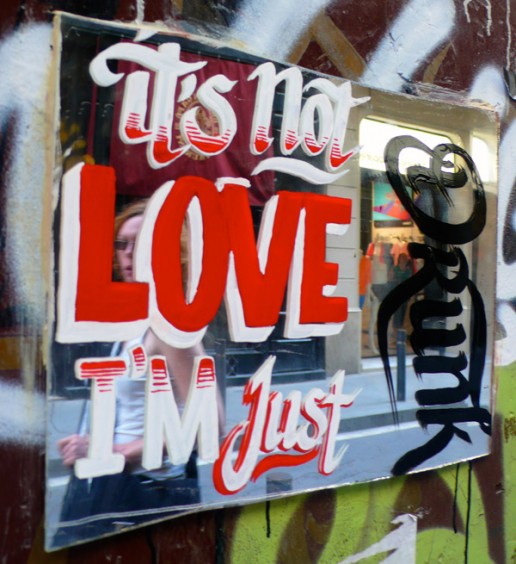
“Regardless of whether I’m doing something big or small, it’s about exploring style of the words and letters,” he says. “Usually in public, the pieces work best when they’re larger and bolder and really have an impact on their environment, and the smaller drawings or even the mirrors can have delicate details because of the time there is to work on them and the way that they’ll be viewed.”
But does work that draws heavily on textual elements require more translation now that Ripo lives and works in dozens of countries?
“Sometimes it’s important to adapt a message to the local language so it can speak to the people there,” he says. “Sometimes by not putting it in a local language, it can actually make people more curious and also stand out more. It depends on what I want to say. I once wrote ‘fuck’ in English in a nice decorative style on a roll-down shutter in Valparaiso, Chile. I would laugh my ass off if I ran into that on a street somewhere. Most people there didn’t understand it, so for them, the way the letters and the word look are what was more important, not the meaning of the word. It’s fun to play with the aesthetics of words versus their meanings.”
Ripo also experiments with a variety of media in his work, from the spray paint associated with graffiti to photography, found objects, and lately, the mirrors that he references above.
“I started using mirrors in 2006 during a tour around Europe,” he says. “Because of how they constantly change with their environment — busy city streets work best — it was a way to make static paintings more dynamic and add more meaning to them. Everyone literally puts themselves into the mirrors and reflects on the message or image that’s there when they’re confronted with it. I also love photographing them, and the way that the image changes and moves with every photo is beautiful.”
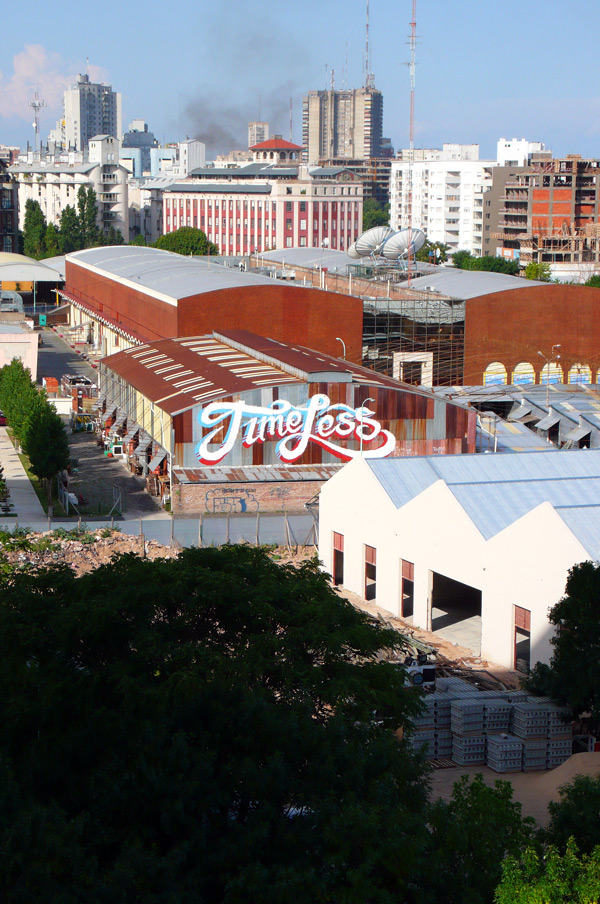
In Istanbul, Barcelona, Bucharest, and Mexico City, Ripo has been confronting passersby with mirrors bearing slogans like “It’s Not Love; I’m Just Drunk” and “You Did It; It’s Okay.” The response, predictably, has been mixed. On his website, Ripo has photographs of people responding with real delight to these meaningful fragments encountered in a cluttered cityscape. But on his blog, he also amusingly recounts the reaction to one of his colorful posters in Zagreb:
“Some color to brighten up a grey day… The guy on the corner didn’t seem so happy when I first put this piece up, and he began yelling at me in Croatian. I had to tell him it was an advertisement before he let me go on my way. I wonder what he would have done had I explained that it was just a gift.”
Ripo’s blog is a key part of his work; it is there that he assimilates and comments on his work, records reactions, and showcases his fine talent for photography, including dozens of city scenes that have a wonderful sense of rhythm and playfulness.
Yet with the exuberance of Ripo’s public and private pieces come questions about the place (both literal and figurative) of public art. In his work, Ripo considers the role of public versus private space, and of what is and is not an appropriate use of the shared visual landscape. Is it true that graffiti and other “broken windows” encourage crime and despair? Or do they rather communicate joy and possibility to members of a community?
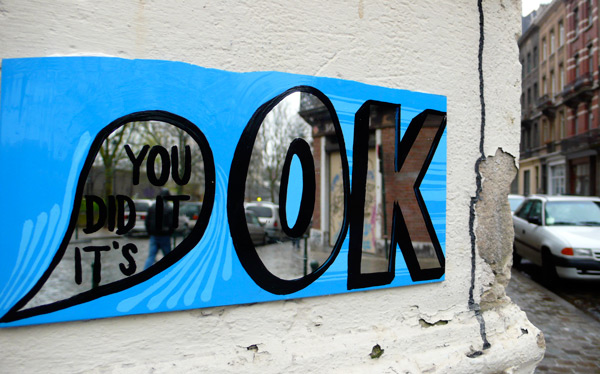
“It depends on the neighborhood,” Ripo says. “Some areas are vastly improved with graffiti; in others, it looks kind of dumb. I think that the best reaction to graffiti or any work in the streets is getting someone to break out of their daily daze and take more notice of what’s around them. That reaction could be anger, amusement, amazement, embarrassment, curiosity, gratitude — it all depends on what’s there and who the person seeing it is. I can’t decide what’s an appropriate use of public space any more than any other one person — it should be public after all — but as an individual, I am actively going to do something about it.”
But Ripo also has moved more of his work indoors. In March, he held his first solo show, …is what I meant to say, in Brussels, and in May, he took part in a Sao Paulo exhibition appropriately titled Caligrafia. Just as Ripo’s work takes on a different color when viewed by English speakers and non-English speakers, seeking out his interior work is a different experience from happening upon his exterior work on the public street.
“When you’re going about your daily life in the streets, a work has to impact you enough to break you out of your normal pace and make you stop and notice it,” he says. “In a gallery, you know what you’re going for more or less, and you are already looking to be affected by what’s inside.
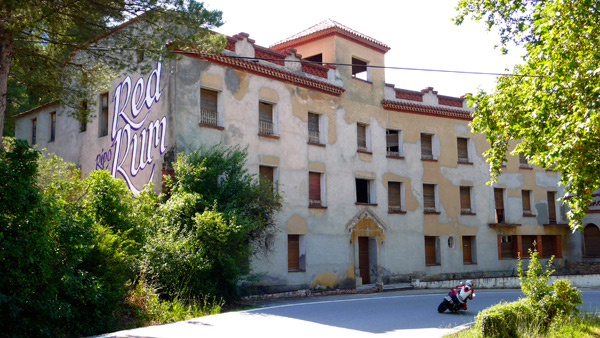
“I couldn’t just do the same thing that I do outside and put it on canvas or paper inside, but at the same time, it was important to show what I’ve done outdoors and how the work indoors fits in with all that. That way, everyone who visits the show, whether or not they know my work, can see all of the different ways that I’m working and how it all ties together.”
Unlike his posters and photos, the exacting wall art that Ripo installs outdoors is usually fated to be tagged, painted over, or taken down, but he remains optimistic even when he watches his work be destroyed only a few days after he finishes it.
“That’s the beauty of working in the streets,” Ripo says. “The work ages, changes, gets covered up, gets torn down. It’s part of the city and changes with the city rather than being an untouchable and preserved object. It hurts the first few times that you see something that you’ve put work into get destroyed or covered up, but it means that you’re also always motivated to do the next thing. I think that’s another reason that a lot of the artists who work in the streets are so prolific. You can’t be stagnant and keep your work and your name up in the streets.”



